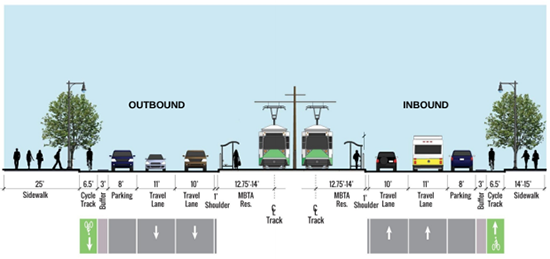Commonwealth Approves Cycle Tracks along Comm Ave
$20 million project part of major multipart reconstruction

A diagram of the redesigned Commonwealth Avenue. Courtesy of the city of Boston
Traveling on Comm Ave is about to get safer, for bicyclists, pedestrians, and drivers alike. State transportation authorities have approved a $20.4 million reconstruction of Commonwealth Avenue between Brookline and Boston, from the BU Bridge to Packard’s Corner, that will include long-awaited cycle tracks between parked cars and sidewalks.
Completion of the project is estimated to take three years, according to Michael Donovan, the University’s vice president for real estate and facility services. The project will begin early next year.
After years of debate about how to make Comm Ave safer for cyclists and pedestrians, a joint BU-city working group in 2013 recommended more warning signs, better bike lane markings, and highway reflectors. The city first unveiled the cycle track plan in March 2015.
“The design is the product of extensive planning and coordination between Boston University, the commonwealth of Massachusetts, the city of Boston, and those commuters that use Comm Ave daily, who all wanted to make sure that the segment is as safe as possible,” says Donovan. “The most vulnerable populations on Comm Ave have been the pedestrians and cyclists, so the goal of the design is to improve safety in addition to improving aesthetics along the sidewalk areas similar to Comm Ave Phase I.”
Comm Ave is one of the most heavily trafficked thoroughfares in Boston, with about 35,000 vehicles, 30,000 pedestrians, and 27,000 Green Line T riders using it daily, according to the Massachusetts Department of Transportation (MassDOT). As for cyclists, the commonwealth estimates about 3,000 a day used the road in 2014.
MassDOT highway administrator Tom Tinlin says the stretch of roadway has “had an inordinate amount of bicycle crashes,” one that resulted in the death of BU student Christopher Weigl (COM’13) in 2012 after a collision with a tractor-trailer at the Comm Ave and St. Paul Street intersection. More than 75 percent of the 121 bike accidents that the Boston University Police Department responded to from 2010 to 2015 occurred on Commonwealth Ave.
The overhaul will do away with bike lanes between parked cars and traffic lanes on the stretch of pavement between Packard’s Corner and the BU Bridge. The bike lanes (which will range from five to six and a half feet) on both sides of Comm Ave will be separated from traffic by a row of parked cars and by three-foot-wide raised buffers between the parked cars and the cyclists, a design similar to that used on some Manhattan streets. The outbound side of the street, which currently has three lanes, will lose a driving lane, bringing it down to two lanes. The inbound side of the street, which currently has only two lanes, will not lose a lane.
David Anderson, MassDOT’s deputy chief for design, says the cycle track will eliminate the hazard of a car door swinging into a bicyclist’s path, and new traffic islands will mean pedestrians have a shorter distance to cross.
The reconstruction will also include water filtration to prevent pollutants from reaching the Charles River, more accessible sidewalks, and new traffic signals that will give transit vehicles preference at stoplights. The cycle tracks will be slightly sloped to prevent the pooling of water.
Another upgrade to the area in summers 2017 and 2018 will be an already approved $81.8 million replacement of the Commonwealth Avenue deck over the Mass Turnpike.
Comments & Discussion
Boston University moderates comments to facilitate an informed, substantive, civil conversation. Abusive, profane, self-promotional, misleading, incoherent or off-topic comments will be rejected. Moderators are staffed during regular business hours (EST) and can only accept comments written in English. Statistics or facts must include a citation or a link to the citation.